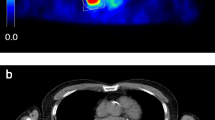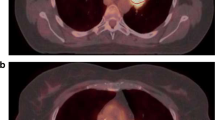Abstract
Purpose
The aim of this study is to assess a software-based method with semiautomated correction for partial volume effect (PVE) to quantify the metabolic activity of pulmonary malignancies in patients who underwent non-gated and respiratory-gated 2-deoxy-2-[18F]fluoro-d-glucose (FDG)-positron emission tomography (PET)/x-ray computed tomography(CT).
Procedures
The study included 106 lesions of 55 lung cancer patients who underwent respiratory-gated FDG-PET/CT for radiation therapy treatment planning. Volumetric PET/CT parameters were determined by using 4D PET/CT and non-gated PET/CT images. We used a semiautomated program employing an adaptive contrast-oriented thresholding algorithm for lesion delineation as well as a lesion-based partial volume effect correction algorithm. We compared respiratory-gated parameters with non-gated parameters by using pairwise comparison and interclass correlation coefficient assessment. In a multivariable regression analysis, we also examined factors, which can affect quantification accuracy, including the size of lesion and the location of tumor.
Results
This study showed that quantification of volumetric parameters of 4D PET/CT images using an adaptive contrast-oriented thresholding algorithm and 3D lesion-based partial volume correction is feasible. We observed slight increase in FDG uptake by using PET/CT volumetric parameters in comparison of highest respiratory-gated values with non-gated values. After correction for partial volume effect, the mean standardized uptake value (SUVmean) and total lesion glycolysis (TLG) increased substantially (p value <0.001). However, we did not observe a clinically significant difference between partial volume corrected parameters of respiratory-gated and non-gated PET/CT scans. Regression analysis showed that tumor volume was the main predictor of quantification inaccuracy caused by partial volume effect.
Conclusions
Based on this study, assessment of volumetric PET/CT parameters and partial volume effect correction for accurate quantification of lung malignant lesions by using respiratory non-gated PET images are feasible and it is comparable to gated measurements. Partial volume correction increased both the respiratory-gated and non-gated values significantly and appears to be the dominant source of quantification error of lung lesions.





Similar content being viewed by others
References
Gould MK, Kuschner WG, Rydzak CE et al (2003) Test performance of positron emission tomography and computed tomography for mediastinal staging in patients with non-small-cell lung cancer: a meta-analysis. Ann Intern Med 139:879–892
Paulino AC, Thorstad WL, Fox T (2003) Role of fusion in radiotherapy treatment planning. Semin Nucl Med 33:238–243
Salavati A, Basu S, Heidari P, Alavi A (2009) Impact of fluorodeoxyglucose PET on the management of esophageal cancer. Nucl Med Commun 30:95–116
Erdi YE, Nehmeh SA, Pan T et al (2004) The CT motion quantitation of lung lesions and its impact on PET-measured SUVs. J Nucl Med 45:1287–1292
Daouk J, Fin L, Bailly P, Meyer ME (2009) Respiratory-gated positron emission tomography and breath-hold computed tomography coupling to reduce the influence of respiratory motion: methodology and feasibility. Acta Radiol 50:144–155
Nehmeh SA, Erdi YE, Meirelles GS et al (2007) Deep-inspiration breath-hold PET/CT of the thorax. J Nucl Med 48:22–26
Liu C, Alessio A, Pierce L et al (2010) Quiescent period respiratory gating for PET/CT. Med Phys 37:5037–5043
Li T, Thorndyke B, Schreibmann E, Yang Y, Xing L (2006) Model-based image reconstruction for four-dimensional PET. Med Phys 33:1288–1298
Rahmim A, Tang J, Zaidi H (2009) Four-dimensional (4D) image reconstruction strategies in dynamic PET: beyond conventional independent frame reconstruction. Med Phys 36:3654–3670
Kesner AL, Kuntner C (2010) A new fast and fully automated software based algorithm for extracting respiratory signal from raw PET data and its comparison to other methods. Med Phys 37:5550–5559
Nehmeh SA, Erdi YE (2008) Respiratory motion in positron emission tomography/computed tomography: a review. Semin Nucl Med 38:167–176
He J, O’Keefe GJ, Jones G et al (2007) Evaluation of geometrical sensitivity for respiratory motion gating by GATE and NCAT simulation. Conf Proc IEEE Eng Med Biol Soc 2007:4165–4168
Dawood M, Lang N, Jiang X, Schafers KP (2006) Lung motion correction on respiratory gated 3-D PET/CT images. IEEE Trans Med Imaging 25:476–485
Nehmeh SA, Erdi YE, Ling CC et al (2002) Effect of respiratory gating on quantifying PET images of lung cancer. J Nucl Med 43:876–881
Chang G, Chang T, Pan T, Clark JW Jr, Mawlawi OR (2010) Implementation of an automated respiratory amplitude gating technique for PET/CT: clinical evaluation. J Nucl Med 51:16–24
Teo BK, Saboury B, Munbodh R et al (2012) The effect of breathing irregularities on quantitative accuracy of respiratory gated PETCT. Med Phys 39:7390–7397
Basu S, Alavi A (2008) Feasibility of automated partial-volume correction of SUVs in current PET/CT scanners: can manufacturers provide integrated, ready-to-use software? J Nucl Med 49:1031–1032. doi:10.2967/jnumed.108.050401, author reply 1032–1033
Hofheinz F, Langner J, Petr J et al (2012) A method for model-free partial volume correction in oncological PET. EJNMMI Res 2:16
Soret M, Bacharach SL, Buvat I (2007) Partial-volume effect in PET tumor imaging. J Nucl Med 48:932–945
Basu S, Zaidi H, Houseni M et al (2007) Novel quantitative techniques for assessing regional and global function and structure based on modern imaging modalities: implications for normal variation, aging and diseased states. Semin Nucl Med 37:223–239
Rousset O, Rahmim A, Alavi A, Zaidi H (2007) Partial volume correction strategies in PET. PET Clin 2:235–249
Chang G, Chang T, Pan T, Clark JW Jr, Mawlawi OR (2010) Joint correction of respiratory motion artifact and partial volume effect in lung/thoracic PET/CT imaging. Med Phys 37:6221–6232
Torigian DA, Lopez RF, Alapati S et al (2011) Feasibility and performance of novel software to quantify metabolically active volumes and 3D partial volume corrected SUV and metabolic volumetric products of spinal bone marrow metastases on 18F-FDG-PET/CT. Hell J Nucl Med 14:8–14
Schaefer A, Kim YJ, Kremp S et al (2013) PET-based delineation of tumour volumes in lung cancer: comparison with pathological findings. Eur J Nucl Med Mol Imaging 40:1233–1244
Saboury B, Salavati A, Brothers A et al (2014) FDG PET/CT in Crohn’s disease: correlation of quantitative FDG PET/CT parameters with clinical and endoscopic surrogate markers of disease activity. Eur J Nucl Med Mol Imaging 41:605–614
Abdulla S, Salavati A, Saboury B, Basu S, Torigian DA, Alavi A (2014) Quantitative assessment of global lung inflammation following radiation therapy using FDG PET/CT: a pilot study. Eur J Nucl Med Mol Imaging 41:350–356
Hickeson M, Yun MJ, Matthies A et al (2002) Use of a corrected standardized uptake value based on the lesion size on CT permits accurate characterization of lung nodules on FDG-PET. Eur J Nucl Med Mol Imaging 29:1639–1647
Vanderhoek M, Perlman SB, Jeraj R (2012) Impact of the definition of peak standardized uptake value on quantification of treatment response. J Nucl Med 53:4–11
Pepin A, Daouk J, Bailly P, Hapdey S, Meyer ME (2014) Management of respiratory motion in PET/computed tomography: the state of the art. Nucl Med Commun 35:113–122
Bland JM, Altman DG (1986) Statistical methods for assessing agreement between two methods of clinical measurement. Lancet 1:307–310
Lin LI (1989) A concordance correlation coefficient to evaluate reproducibility. Biometrics 45:255–268
Barnhart HX, Haber M, Song J (2002) Overall concordance correlation coefficient for evaluating agreement among multiple observers. Biometrics 58:1020–1027
Aristophanous M, Berbeco RI, Killoran JH et al (2012) Clinical utility of 4D FDG-PET/CT scans in radiation treatment planning. Int J Radiat Oncol Biol Phys 82:e99–105
Kawano T, Ohtake E, Inoue T (2008) Deep-inspiration breath-hold PET/CT of lung cancer: maximum standardized uptake value analysis of 108 patients. J Nucl Med 49:1223–1231
Daou D (2008) Respiratory motion handling is mandatory to accomplish the high-resolution PET destiny. Eur J Nucl Med Mol Imaging 35:1961–1970
Schafers KP, Stegger L (2008) Combined imaging of molecular function and morphology with PET/CT and SPECT/CT: image fusion and motion correction. Basic Res Cardiol 103:191–199
Nehmeh SA, Erdi YE, Pan T et al (2004) Four-dimensional (4D) PET/CT imaging of the thorax. Med Phys 31:3179–3186
Dawood M, Buther F, Stegger L et al (2009) Optimal number of respiratory gates in positron emission tomography: a cardiac patient study. Med Phys 36:1775–1784
Kini VR, Vedam SS, Keall PJ, Patil S, Chen C, Mohan R (2003) Patient training in respiratory-gated radiotherapy. Med Dosim 28:7–11
Lupi A, Zaroccolo M, Salgarello M, Malfatti V, Zanco P (2009) The effect of 18F-FDG-PET/CT respiratory gating on detected metabolic activity in lung lesions. Ann Nucl Med 23:191–196
Jiang SB (2006) Technical aspects of image-guided respiration-gated radiation therapy. Med Dosim 31:141–151
Salavati A, Saboury B, Alavi A (2014) Comment on: “tumor aggressiveness and patient outcome in cancer of the pancreas assessed by dynamic 18 F-FDG PET/CT”. J Nucl Med 55:350–351
Zaidi H, El Naqa I (2010) PET-guided delineation of radiation therapy treatment volumes: a survey of image segmentation techniques. Eur J Nucl Med Mol Imaging 37:2165–2187
Acknowledgments
This work was supported by the Swiss National Science Foundation under grant SNSF 31003A-149957.
Conflict of Interest
The authors declare that they have no conflict of interest.
Author information
Authors and Affiliations
Corresponding author
Electronic supplementary material
Below is the link to the electronic supplementary material.
ESM 1
(DOC 537 kb)
Rights and permissions
About this article
Cite this article
Salavati, A., Borofsky, S., Boon-Keng, T.K. et al. Application of Partial Volume Effect Correction and 4D PET in the Quantification of FDG Avid Lung Lesions. Mol Imaging Biol 17, 140–148 (2015). https://doi.org/10.1007/s11307-014-0776-6
Published:
Issue Date:
DOI: https://doi.org/10.1007/s11307-014-0776-6




